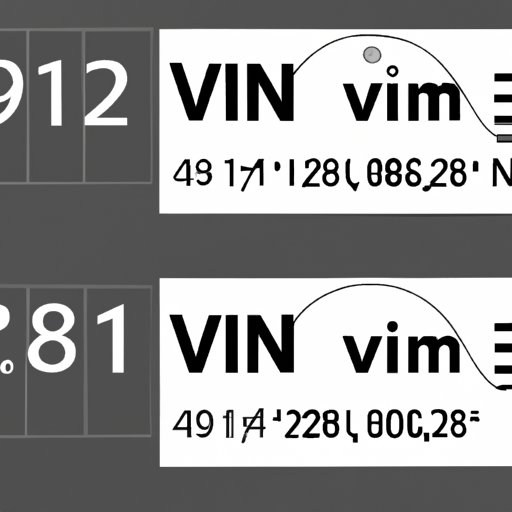I. Introduction
When it comes to buying, selling, or even identifying a vehicle, a VIN number is a crucial piece of information. It can tell you almost everything you need to know about a car, from where it was made to its model and year. Understanding what a VIN number is and how it works can help you make informed decisions in the automotive industry.
This article will provide a comprehensive guide to VIN numbers, including their structure, history, decoding, and adaptation to changing technologies. We will also examine the challenges and benefits of VIN numbers, as well as their role in vehicle tracking, inspection, and sales. Whether you’re a car enthusiast, a seller, or a buyer, this guide will provide you with all the information you need to know about VIN numbers.
II. Understanding the Basics: What is a VIN number and Why is it Important?
A Vehicle Identification Number (VIN) is a unique 17-character code assigned to every car, truck, motorcycle, and trailer manufactured or sold in the United States. VIN numbers are used to identify a vehicle’s make, model, year, production plant, and other features. It is like a fingerprint for a car and can tell you everything about the vehicle, from its original color to its safety features and warranty details.
VIN numbers are essential for various reasons. First, they help prevent car theft by making it harder for a thief to sell a stolen vehicle. Second, VIN numbers help potential buyers make informed purchasing decisions by providing critical information about the vehicle’s history and condition. Third, VIN numbers assist law enforcement agencies in tracking and identifying stolen cars, locating missing persons, and solving crimes.
III. The History of VIN Numbers: Origins, Developments, and Innovations
VIN numbers have been around since the 1950s, but their development and implementation have undergone several changes over the years. Each manufacturer has its unique way of assigning VIN numbers, leading to inconsistencies and confusion across different countries and regions.
In the 1980s, the National Highway Traffic Safety Administration (NHTSA) in the United States introduced a standardized VIN system requiring all vehicles to have a 17-character VIN number, which remains the same today. The system was adopted worldwide, making it easier to track and identify vehicles using a standardized format.
IV. Breaking Down VIN Numbers: Decoding the Meaning Behind Each Character
The VIN number comprises 17 characters, each of which has its unique meaning and significance. The first three characters identify the manufacturer, while the following five describe the vehicle’s features and specifications, such as the model, body type, engine size, and transmission. The ninth character is known as a check digit, which is calculated using an algorithm to ensure the VIN’s validity. The remaining characters indicate the model year, production plant, and serial number.
Deciphering a VIN number can seem daunting, but with the right guide, it becomes easy. Understanding how to decode a VIN number is essential for ensuring that your vehicle’s history and specifications match what the seller is claiming.
V. From Classic Cars to Electric Vehicles: How VIN Numbers Have Adapted to Changing Technologies
The automotive industry has undergone numerous technological advancements that have revolutionized the way vehicles are made and identified. VIN numbers had to adapt to these changes to remain effective in identifying and tracking vehicles accurately.
Electric vehicles, for example, require unique identifiers, such as battery pack information and charging capabilities, added to the VIN number. Self-driving cars may also require specialized VIN numbers to identify autonomous features and functionality.
VI. The Dark Side of VIN Numbers: How Criminals Try to Alter, Forge, or Steal Them
Criminals use various methods to alter, forge, or steal VIN numbers, making it difficult to identify stolen or tampered vehicles. One common technique is to replace the original VIN number with a fake one obtained from a similar vehicle.
Fortunately, there are ways to spot signs of fraud and tampering, such as viewing the VIN on the car’s dash, matching it with other vehicle documents, and checking for misspellings or inconsistencies. Running a VIN check before purchasing a vehicle can also reveal any discrepancies or red flags, including previous accidents, salvage titles, or theft history.
VII. VIN Numbers and Beyond: How Vehicles are Tracked, Inspected, and Sold
VIN numbers are just one of several methods used to track and identify vehicles. Other identification methods include license plates, registration papers, and titles.
Before buying or selling a vehicle, it is essential to conduct a VIN check to ensure that the vehicle’s history and condition match the seller’s claims. During an inspection, VIN numbers can also help identify any potential issues, such as mechanical problems or previous accidents.
VIII. VIN Numbers in the Digital Age: How Technology is Revolutionizing Vehicle Identification
The emergence of new technologies has impacted every aspect of the automotive industry, including VIN numbers. The use of blockchain and artificial intelligence has the potential to provide tamper-proof VIN numbers, enabling more secure tracking and identification of vehicles.
Advanced telematics, such as GPS tracking, can provide real-time location and performance data, enabling remote diagnostics and monitoring of vehicle health. Mobile applications also allow consumers to scan a VIN number to retrieve information about the car’s history, recalls, and maintenance records.
IX. Conclusion
VIN numbers play a crucial role in the automotive industry, enabling efficient identification, tracking, and inspection of vehicles. Whether you’re looking to buy, sell, or identify a car, knowing how to decipher a VIN number can help make an informed decision and prevent fraud and theft. Understanding the history, development, and innovations of VIN numbers can also help prepare you for the exciting technological advancements to come.
Overall, VIN numbers are essential for ensuring safety, compliance, and convenience in the automotive industry. So the next time you spot a VIN number on a vehicle, remember its significance and the critical role it plays in identifying and tracking cars.
